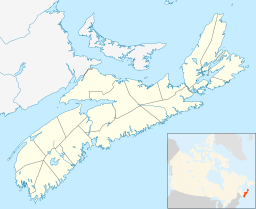Lake Ainslie facts for kids
Quick facts for kids Lake Ainslie |
|
|---|---|
 |
|
| Location | Inverness County, Nova Scotia |
| Coordinates | 46°7′36″N 61°10′34″W / 46.12667°N 61.17611°W |
| Type | Glacial Lake |
| Primary inflows | Trout Brook |
| Primary outflows | Margaree River |
| Basin countries | Canada |
| Max. length | 20 km (12 mi) |
| Max. width | 7 km (4.3 mi) |
| Surface area | 57.4 km2 (22.2 sq mi) |
| Average depth | 5.75 m (18.9 ft) |
| Max. depth | 18 m (59 ft) |
| Water volume | 0.33 km3 (270,000 acre⋅ft) |
| Surface elevation | 57 m (187 ft) |
| Islands | none |
| Settlements | Scotsville, MacCormick's Corner |
Lake Ainslie is a really cool place on Cape Breton Island! It's the biggest natural freshwater lake in all of Nova Scotia. Imagine a huge natural swimming pool – that's Lake Ainslie! A river called the Southwest Margaree River actually starts right here. This river then flows all the way to the big Gulf of Saint Lawrence. The lake is about 20 kilometers long, which is like walking for hours! It's also about 5 kilometers wide on average.
How Lake Ainslie Was Formed
Lake Ainslie was created a very long time ago, during a period called the Pleistocene Epoch. This was about two million years ago! Back then, huge sheets of ice called glaciers covered much of the Earth. As these glaciers melted, they left behind a lot of dirt and rocks. This material, called "glacial outwash," blocked a valley that used to be a river. When the valley was blocked, water filled up the space, forming Lake Ainslie.
The ground under the lake is mostly made of old sedimentary rocks. These rocks are from the Horton and Windsor Formations. They are super old, dating back about 350 million years!
Animals and Plants Around the Lake
Lake Ainslie is a great home for many animals and plants. If you visit, you might even spot some amazing birds! A number of bald eagles, which are large and powerful birds, build their nests around the lake. They love to live near water where they can find fish to eat.
How Lake Ainslie Got Its Name
The lake was named after a person named George Robert Ainslie. He was an important leader on Cape Breton Island a long time ago. From 1816 to 1820, he was the Lieutenant Governor of Cape Breton Island. This was a time when Cape Breton became part of Nova Scotia. So, the lake was named in his honor!



